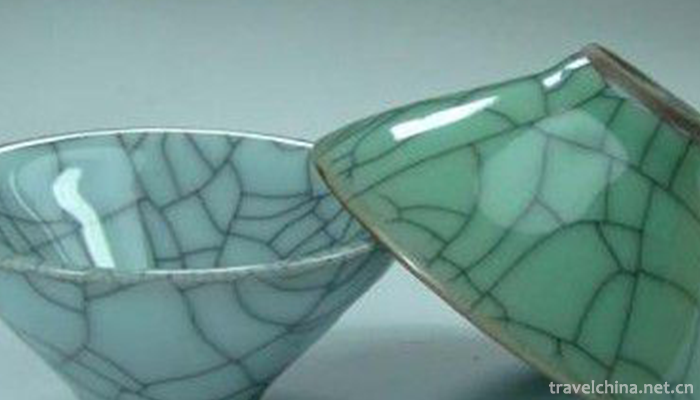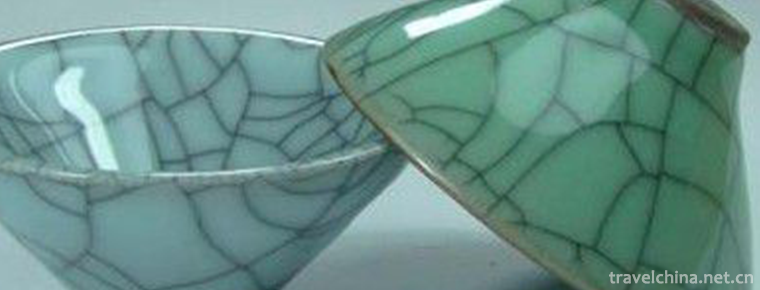Firing Techniques of Wuzhou Kiln Ceramics
Firing Techniques of Wuzhou Kiln Ceramics
The traditional firing technique of Wuzhou kiln is a local traditional handicraft technique in Zhejiang Province. Wuzhou kiln is located in Tiedian Village, Langya Township, Jinhua City. Jinhua was named Wuzhou in the early Tang Dynasty because it was "located in the place where Venus and Wunu competed for beauty" and had a history of more than 1800 years and a splendid culture, which could be regarded as a trend of the ages. It has been listed in the second batch of intangible cultural heritage list of Zhejiang Province.
History of Wuzhou Kiln
As early as the late Neolithic Age more than 4,000 years ago, Chinese ancestors used local clay and lime glaze to make pottery. Wuzhou kilns are widely distributed, mainly in Jinhua, Wuyi, Dongyang and other places. From the Shang and Zhou Dynasties to the late Eastern Han Dynasty, it was fired into mature blue-glazed porcelain with brown glaze; Buddhism prevailed in the Southern Dynasty, lotus flower became a common ornament; the early Tang Dynasty was successfully fired into opaque glaze and flower porcelain; after the Song Dynasty, there appeared painted porcelain, blue-white porcelain and black porcelain; until the Ming Dynasty, blue-and-white porcelain was produced. It lasted for more than 2700 years and found more than 600 ancient kiln sites, which is rare in China.
In addition, the moulding process of Wuzhou kiln has its unique artistic beauty. As early as the Eastern Han Dynasty and the Three Kingdoms period, Wuzhou kiln has been able to skillfully use the skills of kneading, pasting, carving, hollowing, etc. to show people, animals, pavilions and other objects, lifelike and vivid. By the Song Dynasty, high relief appeared. During this period, the stacking technology represented by opaque glazed double dragon plum bottles had reached the peak of perfection. It vividly reproduced people's religion, folk customs, clothing, architecture, acrobatics and other forms of life at that time, which had not been seen in other kilns such as Yueyao kiln. The status and influence of Wuzhou kiln in the history of Chinese ceramics are indelible.
innovate
The application of cosmetic clay on porcelain was an innovation in the ceramic making process of Wuzhou kiln craftsmen in the Western Jin Dynasty. Cosmetic clay is a kind of decorative raw material. It is white porcelain clay with low iron oxide content. After careful washing, it has fine texture and is milky white. The use of makeup clay can make the original rough body surface smooth and smooth, making the original matrix darker gray or dark purple get clever coverage. Appliances that have used cosmetic clay appear smooth and plump glaze after firing, which greatly improves the quality of the products and the aesthetic feeling of the appliances.
It is generally believed that the use of cosmetic clay in utensils may have occurred in the Sui and Tang Dynasties. The archaeological discoveries of Wuzhou kiln prove that it had been widely used as early as the Western Jin Dynasty. For example, a porcelain bowl unearthed from the tomb of Jin Yuankang in Jielu Village, Quzhou City (298) was covered with makeup clay on its surface; the carcass surfaces of the Eastern Jin porcelain bowls, calves and pots unearthed from Wuyi Lutan Village and Wangzhai Village were covered with a layer of milky white makeup clay. In the Eastern Jin Dynasty, cosmetic clay was used in Deqing kiln and other places in Zhejiang Province. Cosmetic clay as a decorative material continued to be used until the Tang Dynasty, and was widely used as an advanced technology in kilns all over the country. Cover the body with makeup clay, and the glaze has a beautiful and bright appearance. The appearance of cosmetic clay has played a positive role in popularizing the porcelain industry, expanding the range of raw materials and improving the quality of porcelain. Mr. Feng Xianming, a famous archaeologist, once praised the use of cosmetic clay in Wuzhou kiln as "a significant creation".
Opacified Glaze
Wuzhou kiln has already fired blue-white opaque glaze in the early Tang Dynasty. Up to now, at least six Wuzhou kilns have been found to have fired blue-white opaque glaze in the early Tang Dynasty. For a long time, the traditional view has been that the production of opaque glaze in Wuzhou kiln was introduced by the craftsmen of Shijun kiln in Linan, the capital of the Southern Song Dynasty. Therefore, the opaque glazed porcelain of Wuzhou kiln is called Nanjun or imitation Jun. The discovery of opaque glazed pottery in Wuzhou kiln in the early Tang Dynasty objected to the traditional viewpoint and was of great significance in verifying the important historical position of Wuzhou kiln.
Wuzhou kiln opaque glaze was successfully burned as early as the early Tang Dynasty. The opaque glaze is caused by the pure two-phase separation. There are few glaze bubbles and residual crystal images in the glaze. The glaze surface is azure or moonwhite, and the sky blue is very few. It has a jade texture and is crystal and beautiful. Since its inception in the early Tang Dynasty, this opaque glaze has continued to the Yuan Dynasty, and has been in vogue, making glaze color a further means of beautifying porcelain, which is rare in the history of China's ceramics.
Mr. Feng Xianming believed that the quality of Wuzhou kiln porcelain was second only to Yue kiln before Tang Dynasty. Wuzhou kiln was the most precious legacy left by ancient Jinhua ancestors to the Chinese nation. Wuzhou kiln is outstanding in the innovation of glaze color. In the mid-Western Han Dynasty, it began to sprinkle brown glaze on the green glaze, which increased the ornamental value of the objects.
New Jun Porcelain
In 1976, archaeologists salvaged more than 10,000 pieces of Yuan Dynasty Chinese ceramics, hundreds of lacquer wares and hundreds of metal objects, and more than 100,000 coins in the Xin'an Sea off the southwestern corner of South Korea. The last coin in the shipwreck was "Datongbao". It can be seen that the time of the accident should be in the Yuan Dynasty. Besides the products of Longquan in Zhejiang and Jingdezhen in Jiangxi, there are also many products of Wuzhou kiln. At that time, many people thought that it was a "imitation Jun kiln" in the north, because the opaque glaze on the utensils was very similar to the Jun kiln. Later, experts unearthed such specimens in Jinhua Tieton kiln to solve the mystery. There is a three-legged basin in the collection of the Imperial Palace in Taiwan, which is similar to the water from Xin'an Sea, Korea. It is likely that it is also the product of Tiedian Kiln. It can be seen that Tiedian Kiln also fired ceramics for Palace display.
"Xin'an Shipwreck Relics" describes the fetal bones of Jun-glazed porcelain in water as follows: "Jun-glazed porcelain has flowerpots, water dishes, pot-shaped water injection, etc. Because the glaze medicine and clay are obviously different from the Jun glaze of the Yuan Dynasty in the north, it is possible that the South imitates the products of the north. The matrix earth is slightly rougher than that in the north. In addition to the black glaze, there is gray on the glaze. After twice glazing, the matrix earth is slightly rougher than that in the north. Nevertheless, no cinnabar emits red, no milky white, only beautiful sky blue. "Although two glazes were applied, no glaze was applied on the feet, the bottom and the outer bottom of the periphery, and there were traces of two glazes applied at the junction of the exposed part. The exposed part looks gray with brown, rough tire soil, gray-white, blue-blue glaze, mottled, thick glaze but not flowing, the accumulation part is gray-white and deep, cinnabar is completely not reddish.
How Wuzhou kilns are exported? Experts believe that they are exported from Hangzhou or after transshipment to Mingzhou (now Ningbo, Zhejiang Province). In recent years, when cities and towns in Hangzhou and Ningbo were constructed, fragments of Tieton kiln products were found. More than 10,000 pieces of Yuan Dynasty Chinese ceramics coming out of Xin'an sea area in South Korea are likely to start from Hangzhou. Celadon comes from Longquan kiln system, Qingbai comes from Jingdezhen, Jun glaze comes from Jinhua area. At that time, most of the export goods had to be transshipped from Hangzhou. History records that the sea route was from Hangzhou to Japan at that time, and it could be reached seven days and seven nights downwind. In Tang, Song and Yuan Dynasties, Wuzhou kiln opaque glazes were exported to foreign countries in large quantities, which contributed to the exchange of world economy and culture.


-
2.Guilin Yaoshan Scenic Area
Yaoshan is located in the eastern suburb of Guilin City, 8 kilometers away from the city center. The main peak is 909.3 meters above sea level and 760 meters above sea level. It is the highest peak in
Time 2019-01-13 -
3.Mount Tai Fonters Happy World
Tai'an Fangte Happy World is located in the eastern New Area of Taishan District, Tai'an City, Shandong Province. Font's Happy World is characterized by science fiction and animation
Time 2019-02-13 -
4.Xumishan Grottoes
Xumishan Grottoes, located 55 kilometers northwest of Guyuan City, Ningxia, is located in the north of Liupan Mountain. It is the only way to the east of the ancient "Silk Road" and one of t
Time 2019-02-26 -
5.Drama Costume and Opera Production Skills
Drama costume and costume production skills, local traditional handicraft in Suzhou City, Jiangsu Province, one of the national intangible cultural heritage.
Time 2019-05-08 -
6.Printing and Dyeing Techniques of Blue Printed Cloth
The printing and dyeing technology of blue printed cloth is a kind of anti-dyeing and printing method of indigo printed cloth. The dye is extracted from Polygonum multiflorum.
Time 2019-05-11 -
7.Miao Flower Jumping Festival
Flower Dancing Festival is a traditional festival of the Miao people in Anshun. Legend has it that Yang Lu, a hero of the Miao people, rose up. Till now, Huashan, outside the North Gate of Anshun, is
Time 2019-06-05 -
8.Chak Chak
"Chuck Chuck" is a highly interactive dialogue between two or more people. According to the different content and language characteristics, it can be roughly divided into five types:
Time 2019-06-10 -
9.Qingyang Opera
During Jiajing period of Ming Dynasty, Yiyang Tune of Jiangxi flowed into Qingyang County of Chizhou Prefecture in Southern Anhui Province. It was combined with local language, folk opera (Kunshan Tun
Time 2019-06-11 -
10.Brewing Techniques of Shaoxing Yellow Rice Wine
Shaoxing has a long history of brewing wine, which can be traced back to the Spring and Autumn Period and the Warring States Period. By the time of the Northern and Southern Dynasties, it was well-kno
Time 2019-06-14 -
11.Sachet
Incense bag is also called odor-tolerant, incense bag, incense bag, incense sauce, Pei Mo. Nowadays people call it purse, toy and dim. It is a folk embroidery handicraft created by ancient Chinese wor
Time 2019-07-03 -
12.Neijiang climate
Neijiang City belongs to subtropical humid monsoon climate. Affected by the basin and the natural environment, it has the characteristics of mild climate, abundant rainfall, sufficient light and heat, and long frost free period. It is warm in winter and hot in summer,
Time 2020-12-16